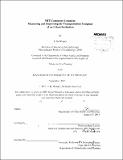| dc.contributor.advisor | Kent Larson. | en_US |
| dc.contributor.author | Winder, James Ira | en_US |
| dc.contributor.other | Massachusetts Institute of Technology. Department of Urban Studies and Planning. | en_US |
| dc.date.accessioned | 2014-01-23T18:43:29Z | |
| dc.date.available | 2014-01-23T18:43:29Z | |
| dc.date.copyright | 2013 | en_US |
| dc.date.issued | 2013 | en_US |
| dc.identifier.uri | http://hdl.handle.net/1721.1/84426 | |
| dc.description | Thesis (M.C.P.)--Massachusetts Institute of Technology, Department of Urban Studies and Planning, 2013. | en_US |
| dc.description | Cataloged from PDF version of thesis. | en_US |
| dc.description | Includes bibliographical references (pages 49-51). | en_US |
| dc.description.abstract | This thesis develops a system for observing, visualizing, and understanding transportation behavior at the scale of an urban institution's entire population. In particular, the Massachusetts institute of Technology (MIT) will serve as a case study. This research does not accept the presumption that the individual is a purely autonomous decision maker when it comes to transportation behavior. Rather, decisions can be a result of following the example of others' in a given community, not necessarily a process of autonomous utility optimization. As such, human transportation behavior is examined within the context of "social institutional" and "urban tribal" constructs. By recognizing such social institutional tribes as fundamental affecters of transportation behavior, we can develop new analytical units called "commuter footprints." These footprints are derived from the "digital breadcrumbs" of user behavior within an institution. By bringing these footprints to light, it will give policy makers a new avenue to influence transportation behavior in urban areas by targeting these social institutional tribes as a whole. Given the growing desire for policies to be evaluated with performance-based metrics, this thesis also strives to articulate metrics for a social institution's transportation behavior. These metrics will aid in annual reporting, and may even serve as useful indicators from which to measure change over time. Furthermore, the thesis proposes potential avenues for "living lab" style research and experiments that could utilize such a system. | en_US |
| dc.description.statementofresponsibility | by J. Ira Winder. | en_US |
| dc.format.extent | 51 pages | en_US |
| dc.language.iso | eng | en_US |
| dc.publisher | Massachusetts Institute of Technology | en_US |
| dc.rights | M.I.T. theses are protected by
copyright. They may be viewed from this source for any purpose, but
reproduction or distribution in any format is prohibited without written
permission. See provided URL for inquiries about permission. | en_US |
| dc.rights.uri | http://dspace.mit.edu/handle/1721.1/7582 | en_US |
| dc.subject | Urban Studies and Planning. | en_US |
| dc.title | MIT commuter common : measuring and improving the transportation footprint of an urban institution | en_US |
| dc.title.alternative | Measuring and improving the transportation footprint of an urban institution | en_US |
| dc.type | Thesis | en_US |
| dc.description.degree | M.C.P. | en_US |
| dc.contributor.department | Massachusetts Institute of Technology. Department of Urban Studies and Planning | |
| dc.identifier.oclc | 868071786 | en_US |
